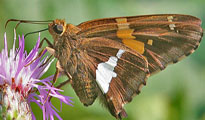Native Plants
Search for native plants by scientific name, common name or family. If you are not sure what you are looking for, try the Combination Search or our Recommended Species lists.
Apios americana
Apios americana Medik.
Groundnut, Wild Potato, Indian Potato
Fabaceae (Pea Family)
Synonym(s): Apios americana var. turrigera, Glycine apios
USDA Symbol: APAM
USDA Native Status: L48 (N), CAN (N)
Climbing vine with maroon or reddish-brown pea-like flowers in compact racemes arising from leaf axils.
This legume has a cord-like rootstalk with edible tubers the Indians gathered for food. The Pilgrims relied on them as a food source during their initial years in Massachusetts. The tubers can be used in soups and stews or fried like potatoes; the cooked seeds can also be eaten. The flowers are sufficiently beautiful to warrant cultivation, but the plant tends to take over. The generic name, from Greek for "pear," alludes to the shape of the tubers. Price's Groundnut (A. priceana), a rare species with greenish-white flowers and purple tips, occurs in Kentucky, Tennessee, and southern Illinois.
Plant Characteristics
Duration: PerennialHabit: Vine
Leaf Arrangement: Alternate
Fruit Type: Legume
Size Notes: Stems up to about 15 feet long.
Leaf: Green
Fruit: Brown
Bloom Information
Bloom Color: Red , Pink , PurpleBloom Time: Jul , Aug , Sep
Distribution
USA: AL , AR , CO , CT , DC , DE , FL , GA , IA , IL , IN , KS , KY , LA , MA , MD , ME , MI , MN , MO , MS , NC , ND , NE , NH , NJ , NY , OH , OK , PA , RI , SC , SD , TN , TX , VA , VT , WI , WVCanada: NB , NS , ON , PE , QC
Native Distribution: New Brunswick and Nova Scotia; New England south to Florida; west to Louisiana and Texas; north to Minnesota, particularly Great Lakes area.
Native Habitat: Moist, low sites and thickets.
Growing Conditions
Water Use: MediumLight Requirement: Shade
Soil Moisture: Moist , Wet
CaCO3 Tolerance: High
Benefit
Use Food: Tubers and seeds edible.Conspicuous Flowers: yes
Fragrant Flowers: yes
Attracts: Butterflies
Larval Host: Silver-spotted Skipper (Epargyreus clarus)
Butterflies and Moths of North America (BAMONA)
|
Silver-spotted Skipper (Epargyreus clarus)  Larval Host |
Mr. Smarty Plants says
Edible Plants for North Georgia
January 10, 2010
We are planning a forest food garden in the hollers of the N GA Mountains.
Which edible fruit, nut, berry, herb and creepers would be best for this reddish, clay-like soil? The food garden is in...
view the full question and answer
Vines for shade in North-Central Georgia
August 07, 2009
I am looking for something to hide a 6' wood fence that will grow in almost full shade. I have an area approx 2 feet wide to plant in. Since the fence and planting areas are stepped -- about 8 feet f...
view the full question and answer
National Wetland Indicator Status
| Region: | AGCP | AK | AW | CB | EMP | GP | HI | MW | NCNE | WMVE |
| Status: | FACW | FACW | FAC | FACW | FACW | FACW |
From the National Organizations Directory
According to the species list provided by Affiliate Organizations, this plant is on display at the following locations:Mt. Cuba Center - Hockessin, DE
Bibliography
Bibref 1186 - Field Guide to Moths of Eastern North America (2005) Covell, C.V., Jr.Bibref 1185 - Field Guide to Western Butterflies (Peterson Field Guides) (1999) Opler, P.A. and A.B. Wright
Search More Titles in Bibliography
Additional resources
USDA: Find Apios americana in USDA PlantsFNA: Find Apios americana in the Flora of North America (if available)
Google: Search Google for Apios americana
Metadata
Record Modified: 2018-11-30Research By: TWC Staff